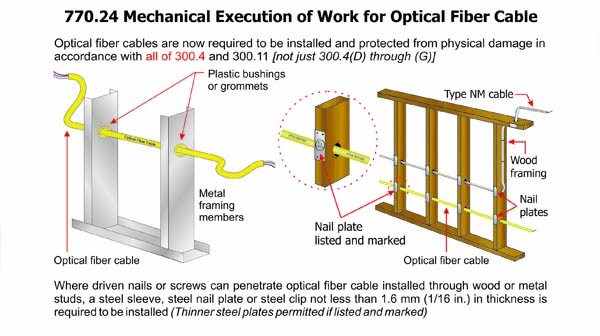770.24 Optical Fiber Cable
Change Summary
- Optical fiber cables are now required to be installed and protected from physical damage in accordance with the entirety of 300.4 and 300.11.
| NEC® Text |
|---|
|
770.24 Mechanical Execution of Work. Material taken from the National Electric Code® is reprinted with permission from NFPA 70®, 2020 edition. |
Expert Analysis
For the 2020 NEC, the requirements of 770.24 were revised to require optical fiber cable to be installed and protected from physical damage to conform with all of 300.4 in its entirety and 300.11. Optical fiber cables are not limited to communications installations and need protection against physical damage regardless of whether they can be a shock hazard or not. Just because optical fiber cable is not carrying any current, the equipment being supplied by this optical fiber cable in several situations is critical to life and safety. Therefore, the installation of these optical fiber cables should conform to all of 300.4. Optical fiber cables are used for life safety applications such as for fire alarm systems, some building system controls and industrial process controls. Any type of damage to the optical fiber cable can cause failure to the use and operation of the cable and/or systems they are part of such as the fire alarm system.

Leviton Fiber Leviton offers comprehensive fiber choices for every application.
Fiber Optic Patching Platforms:

Delivering the industry’s most innovative family of solutions. From the ultra-high density Opt-X® HDX platform and the high density cassette-based e2XHD system to the versatile Opt-X® SDX platform and the LightSpace® system designed for LGX accessories, you can maximize your network manageability and performance.

Meeting fiber network migration from 10 to 40, 100, 200, 400 Gb/s and beyond. Offering the most options to reuse your fiber backbone over multiple network upgrades, Opt-X® Unity is the first complete single-mode and multimode 24-fiber solution. The Opt-X® Enterprise system offers 8- and 12- fiber options designed to maximize your network return on infrastructure investment.







